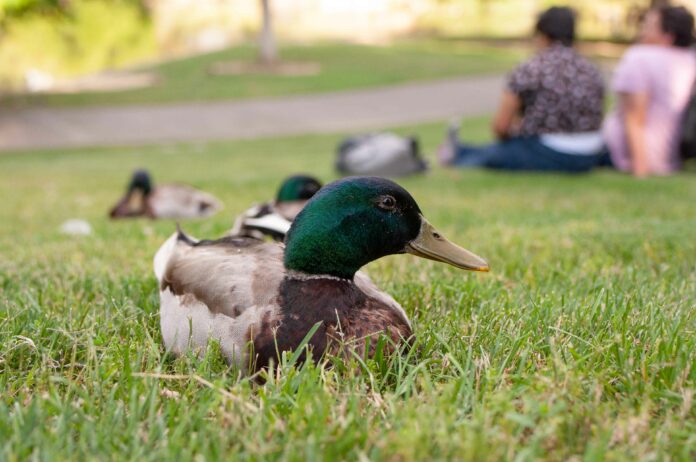Davis students, community members can appreciate native wildlife, nature right outside their doors
Besides the students, professors and faculty who can be seen on campus, there are also fox squirrels, yellow-billed magpies, gopher snakes, burrowing owls and more that can also be spotted around UC Davis. Over 150 animals call this campus their home, just as any student might.
Spanning over 5,300 acres, the Davis campus contains a diverse wildlife population in varying locations, according to Assistant Director of the UC Davis Arboretum Andrew Fulks who noted that in the core campus area alone, one may find squirrels, turkeys, ducks, crows, scrub jays and mockingbirds. In the more rural parts, however, like west and south campus, owls, yellow-billed magpies, lizards, frogs and bobcats can be observed.
Additionally, in the arboretum, mallards, wood ducks, mergansers and foxes can be seen at different times of year.
Most of the plants and animals living on campus can also be found throughout the city of Davis. The areas with more wide open spaces and fewer buildings have more wildlife, according to Fulks.
John McNerney, a wildlife resource specialist for the City of Davis, said these species were able to adjust to city living over time.
“Within the City of Davis limits we find many common native species that have adapted well to the urban landscape and human activity,” McNerney said. “I’d estimate the City of Davis hosts over 150 species of birds, around 20 mammalian species, at least seven species of reptiles and about five amphibians […] There are also hundreds, if not thousands of invertebrate species.”
He explained that most plants found in Davis are typical of urban landscaping found across the Central Valley ecotype, but this area in particular also has a high density of native species supporting other urban wildlife. Species living in urban environments will often utilize a variety of food and shelter resources, thus benefiting from human activity.
Living on the UC Davis campus is thought to be relatively easy for most organisms, Fulks said. Plants receive regular watering, trees get structural pruning, and animals have abundant food and shelter, as well as few predators.
“The lack of major predators also allows some species, like the ducks, to be more abundant than they would be in more wild areas,” Fulks said.
This doesn’t mean Davis animals live worry-free lives, however. Habitat destruction, as well as disturbances caused by cars, bikes, feral cats and domestic pets all pose threats to wildlife, according to Fulks.
The City of Davis tries to reduce these challenges by fully adopting and upholding state and federal regulations related to the protection of wildlife. The city also provides education to residents about how to protect nature.
Laci Gerhart-Barley, a lecturer in the department of evolution and ecology, explained why the arboretum allows for a unique nature experience.
“One thing that is really cool about campus is that you have the arboretum, which is this less human-managed, slightly more natural area right next to campus that we can interact with and see totally different stuff there than you would see in town,” Gerhart-Barley said.
Gerhart-Barley teaches a new course offered every spring called Evolution and Ecology 16: Wild Davis, or EVE 16. The class focuses on urban ecology and nature that can been seen in human-driven systems. Since the class serves as a California naturalism training course, students learn about components of geology, history, social dynamics, how scientists study concepts and what it means to be an environmentalist or naturalist.
In the class, Gerhart-Barley and her students visit various parts of campus and observe different ecological questions, such as pollinator interactions between some of the flower gardens on campus, or take surveys of ants in the arboretum.
“A big thing I am trying to instill in the students in the class is that nature isn’t something that is somewhere else,” Gerhart-Barley said. “You can be in an urban setting and still be interacting with nature. There are still ecological interactions and organisms around you. There’s more going on than you realize.”
Written by: Margo Rosenbaum — features@theaggie.org





Nice article. It is unfortunate that UC Davis also promotes feral cat colonies on it’s campus by neutering, feeding, and maintaining them instead of removing them. Fed or not — neutered or not, these cats take a heavy toll on the wildlife mentioned in the article. And while the wildlife belongs there, domestic animals such as cats do not. Recent research shows that free-roaming cats kill an estimated 2.4 billion birds annually in the U.S. The UC Davis cats are contributing to this. The same research shows that free-roaming cats also kill some 12.6 billion small mammals and hundreds of thousands of reptiles and amphibians. Estimates on the numbers of butterflies, moths, and other invertebrates killed are unknown. I encourage UC Davis to look at the facts and the research. Stop maintaining cats on campus. Remove them and take them to a shelter where they can either be placed in indoor homes or humanely euthanized. 150+ species of birds, 20 species of mammals, 7 species of reptiles, 5 species of amphibians, and many, many species of invertebrates will thank you. And so will thousands of people who care about the environment and native wildlife.